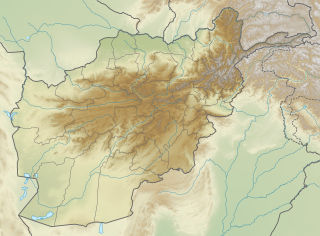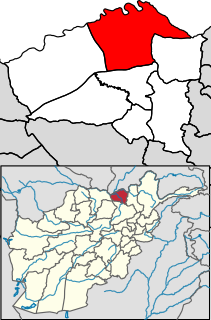
Badakhshan is a historic region comprising parts of what is now northeastern Afghanistan, eastern Tajikistan, and the Tashkurgan county in China. The name is retained in Badakhshan Province, which is one of the 34 provinces of Afghanistan and is located in Northeastern Afghanistan. Much of historic Badakhshan lies within Tajikistan's Gorno-Badakhshan Autonomous Region, located in the southeastern part of the country. The music of Badakhshan is an important part of the region's cultural heritage.

Kunduz is a city in northern Afghanistan, which serves as the capital of Kunduz Province. The city has a population of about 268,893, making it about the 6th-largest city of Afghanistan, and the largest city in the northeastern section of the country. Kunduz is located in the historical Tokharistan region of Bactria, near the confluence of the Kunduz River with the Khanabad River. Kunduz is linked by highways with Kabul to the south, Mazar-i-Sharif to the west, and Badakhshan to the east. Kunduz is also linked with Dushanbe in Tajikistan to the north, via the Afghan dry port of Sherkhan Bandar.

Kunduz or Qunduz is one of the 34 provinces of Afghanistan, located in the northern part of the country next to Tajikistan. The population of the province is around 953,800, which is mostly a tribal society; it is one of Afghanistan's most ethnically diverse provinces with many different ethnicities in large numbers living there. The city of Kunduz serves as the capital of the province. It borders the provinces of Takhar, Baghlan, Samangan and Balkh. The Kunduz Airport is located next to the provincial capital.

Baghlan is a city in northern Afghanistan, in the eponymous province, Baghlan Province. It is located three miles east of the Kunduz River, 35 miles south of Khanabad, and about 500 metres above sea level in the northern Hindu Kush.

Kunduz Airport is a public and military airport located 5 miles (8 km) south-southeast of Kunduz, a city in Kunduz Province in Afghanistan. It is also 9 miles (14 km) west of Khan Abad, 25 miles (40 km) south of the Oxus River, and 33 miles (53 km) south of the Tajikistan border.

Baghlani Jadid is a district of Baghlan Province in northern Afghanistan. It has a population of about 119,607.

Chārdara District is one of the seven districts in Kunduz Province in northern Afghanistan. It is situated in the south-west part of Kunduz Province and has borders with Qalay-I-Zal District to the north-west, Kunduz District to the north-east, Ali Abad District to the south-east, Baghlan Province to the south and Samangan Province to the south-west.

Imam Sahib District is situated in the northern part of Kunduz Province, Afghanistan. It borders with Qalay-I-Zal District to the west, Tajikistan to the north, with Archi District to the east and Kunduz District to the south. The population is 204,300 (2006) - 25% Pashtun, 25% Tajik, 45% Uzbek and 5% Turkmen. The district center is the town of Imam Sahib, located in the northern part of the district. The other main town in the district is Sherkhan Bandar, which serves as Afghanistan's main port of entry to Tajikistan.

The Nasher are a noble Afghan family and Khans of the Pashtun Kharoti (Ghilji) tribe. The family is originally from Qarabagh, Ghazni but founded modern day Kunduz in the early 20th century and lived there until the end of the Barakzai dynasty in the late 20th century. Members of the family now live in the United States, in the United Kingdom, and in Germany.

The Kunduz airlift, also called the Airlift of Evil, refers to the alleged evacuation of hundreds of top commanders and members of the Taliban and their Pakistani advisers including Pakistani Inter-Services Intelligence agents and army personnel, and other Jihadi volunteers and sympathizers, from the city of Kunduz, Afghanistan, in November 2001 just before its capture by U.S. and United Front of Afghanistan forces during the War in Afghanistan. The Taliban and Al-Qaeda combatants were allegedly evacuated from Kunduz and airlifted by Pakistan Air Force cargo aircraft to Pakistan Air Force bases in Chitral and Gilgit in Azad Kashmir's Northern Areas. The United States and Pakistan denied that the airlift took place. However, all evidences point to the contrary and USA had to accept the Pakistan claims in spite of evidences to the contrary. General Richard Myers, Chairman of the Chiefs of Staff, said that the Kunduz airfield had been disabled by United States attacks. Donald Rumsfeld, US defense secretary, said on December 2 that "neither Pakistan nor any other country flew any planes into Afghanistan to evacuate anybody".

Ahandara is a valley and settlement in Takhar Province on the Kunduz River. The valley is crossed by the road from Kunduz to Faizabad, and located about 22 miles west of Teshkhan. There is also a village by the same name in Badakhshan Province, located on the road from Taloqan to Faizabad, about 15 miles west of the Lataband Pass.

Amrut is the name of a village in Kunduz Province in the Khinjan valley near the mouth of the Bajgah glen, about six miles east of Khinjan. It has earlier been inhabited by Koh-i-Gadi Hazaras.

The Siege of Kunduz took place in 2001 during the War in Afghanistan. After the fall of Mazar-i-Sharif on November 9, the focus of the Northern Alliance advance shifted towards the city of Kunduz, which was the last remaining Taliban stronghold in northern Afghanistan.

Mohammad Omar was the Governor of Kunduz Province, Afghanistan. He was an ethnic Andar Pashtun from Baharak District of Afghanistan.

The Battle of Kunduz took place from April to October 2015 for control of the city of Kunduz, located in northern Afghanistan, with Taliban fighters attempting to seize the city and displace Afghan security forces. On 28 September 2015, the Taliban forces suddenly overran the city, with government forces retreating outside the city. The capture marked the first time since 2001 that the Taliban had taken control of a major city in Afghanistan. The Afghan government claimed to have largely recaptured Kunduz by 1 October 2015 in a counterattack, although local sources in the city disputed the claim made by government officials.

On 3 October 2015, a United States Air Force AC-130U gunship attacked the Kunduz Trauma Centre operated by Médecins Sans Frontières in the city of Kunduz, in the province of the same name in northern Afghanistan. It has been reported that at least 42 people were killed and over 30 were injured.

On May 31, 2016, Taliban militants posing as government officials kidnapped around 220 civilians at a fake checkpoint along the Kunduz-Takhar highway near Arzaq Angor Bagh in Kunduz province, Afghanistan, on the outskirts of the city of Kunduz.

The Battle of Kunduz occurred on 3 October 2016 in the Afghan city of Kunduz between Afghan National Security Forces and Taliban insurgents. It occurred exactly a year after the 2015 battle when the Taliban briefly controlled the city.

The Battle of Boz Qandahari occurred on 3 November 2016, in the village of Boz Qandahari, on the western outskirts of the Afghan city of Kunduz, between Afghan National Army Commandos alongside United States Army Special Forces against Taliban insurgents.

The Kunduz madrassa attack was an Afghan Air Force (AAF) airstrike that killed and injured many civilians at the Akhundzada Gojor Madrassa in the Dasht-e-Archi region of Kunduz, Afghanistan on 2 April 2018. The target of airstrike was a religious gathering at a Madrassa. A graduation ceremony was taking place at the Madrassa and hundreds of people were attending the ceremony at the time of airstrike. Initially, Afghan Government claimed that airstrike had killed scores of Taliban and denied any civilian casualties took place. But later the Afghan Government admitted that civilians were killed in the airstrike. Local residents from Dasht-e-Archi deny that any Taliban were present at the Madrassa. They said that only children and civilians were targeted and there were no Taliban among the casualties.















